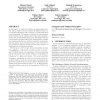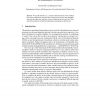832 search results - page 14 / 167 » Effect of Malicious Synchronization |
JCM
2008
13 years 9 months ago
2008
The open, sharing and anonymous nature of peer-to-peer (P2P) network has offered opportunities and threats for the development of distributed computing technology. One feasible way...
CLUSTER
2008
IEEE
13 years 10 months ago
2008
IEEE
We investigate operating system noise, which we identify as one of the main reasons for a lack of synchronicity in parallel applications. Using a microbenchmark, we measure the no...
PODC
2009
ACM
14 years 7 months ago
2009
ACM
In this paper, we study the wireless synchronization problem which requires devices activated at different times on a congested single-hop radio network to synchronize their roun...
DATE
2006
IEEE
14 years 3 months ago
2006
IEEE
In traditional parallel co-simulation approaches, the simulation speed is heavily limited by time synchronization overhead between simulators and idle time caused by data dependen...
WDAG
2001
Springer
14 years 2 months ago
2001
Springer
We provide effective (i.e., recursive) characterizations of the relations that can be computed on networks where all processors use the same algorithm, start from the same state, a...


